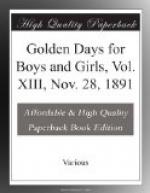The coarse oil which Stauf procured had little in it to his eye, but it contained, nevertheless, many bright and varied colors, delicate perfumes, useful medicines and the sweetest product ever known to man.
From coal-tar is derived benzine and naphtha, and colors—especially purples—which are used in dyeing. From one ton of good cannel coal, distilled in gas retorts, there comes ten thousand cubic feet of gas, twenty-five gallons of ammoniacal liquor, thirty pounds of sulphate of ammonium, thirteen hundred weight of coke and twelve gallons of coal-tar.
From this tar are produced a pound of benzine, a pound of toluene, a pound and a half of phenol, six pounds of naphthalene, a small quantity of a material called xylene and half a pound of anthracene, which is used in dyeing.
From benzine are derived fine shades of yellows, browns, oranges, blues, violets and greens; from the toluene are obtained magentas and rich blues; from phenol, beautiful reds; from naphthalene, reds, yellows and blues; from xylene, brilliant scarlets, and from anthracene, yellows and browns.
Out of one pound weight of cannel coal can be produced dyes sufficient to color the following lengths of flannel, three quarters of a yard wide: Eight inches of magenta, two feet of violet, five feet of yellow, three and a half feet of scarlet, two inches of orange and four inches of Turkey red.
There are immense varieties of these colors, and the best part about them is that no illness comes to the hands employed in mixing or using them, as is the case with some other dyes.
Some years ago, quinine became very dear, but it had no equal as a medicine for certain purposes, and so experiments were made to produce artificial quinine by chemical means. In this way “kairene” and “quinoline” were produced, at about half the price of quinine. But the most important result of the search was the discovery of anti-pyrine, which is extensively used in high fevers.
Coal-tar is about the last substance from which a sweet perfume could be expected, and yet it gives many. All the “extract of new-mown hay” now comes from it. This lovely scent used to be produced, at great expense, from scented grasses. Then there is the scent of vanilla, and the growers of the vanilla bean have lost greatly in consequence. There is also heliotrope perfume prepared from coal-tar, and other extracts for scenting toilet soaps.
But the most remarkable of all the products of coal-tar is saccharine, which was first discovered by Fahlberg, a German, who was conducting experiments in coal-tar under the direction of Professor Remsen, of the Johns Hopkins University, in Baltimore.
This substance is infinitely sweeter than any cane-sugar—more than two hundred times as sweet—so that the smallest drop sweetens more than a tablespoonful of sugar. But it does not nourish like cane or beet sugar, while at the same time it is not injurious, and it preserves fruit perfectly.




